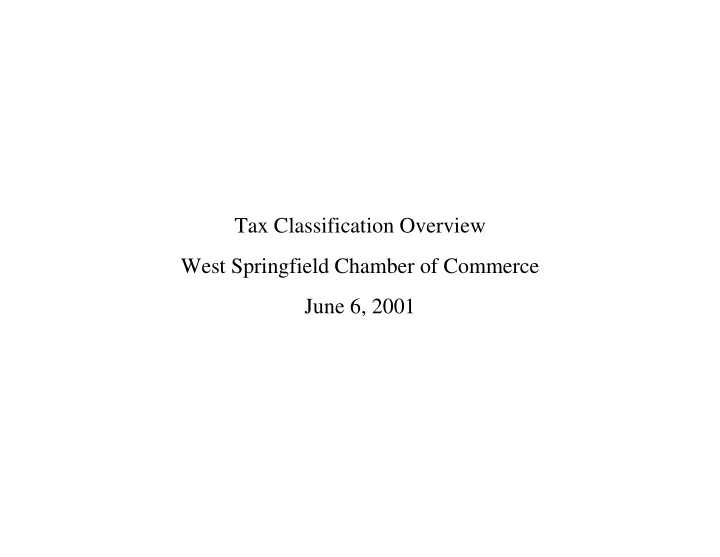

Tax Classification Overview West Springfield Chamber of Commerce June 6, 2001
Tax Classification Overview June 6, 2001 Section Topic 1 Trends in Massachusetts Property Taxes C Property tax burdens: Massachusetts versus U.S. 2 Tax Classification Overview C History C 102 communities classify: - Ratio of business tax rate to overall average tax rate - Actual rates 3 Impact of Classification on Business Taxpayers C Share of property taxes paid in classified versus non-classified communities C Percent of assessed value versus percent of levy C Tax burden shifted to business
Section 1 Trends in Massachusetts Property Taxes
Property Taxes -- MA vs. US Property Taxes Per Capita in Constant 1997 Dollars $1,500 82.3% MA Difference from US Average $1,250 83.4% 34.7% 49.1% 24.3% $1,000 28.9% $750 $500 $250 $0 1970 1975 1980 1985 1990 1995 Fiscal Year Massachusetts US Average
Property Taxes -- MA vs. US Property Taxes Per $1,000 of Personal Income $80 72.6% MA Difference from US Average 36.2% 76.1% $60 13.0% 13.8% $40 3.3% $20 $0 1970 1975 1980 1985 1990 1995 Fiscal Year Massachusetts US Average
Section 2 Tax Classification Overview
Property Tax Classification ! Prior to 1961, all communities taxed classes of property at a single rate, but many used differing assessment ratios (fractions of the market value) in determining the tax for the different classes. ! 1961 SJC decision ruled that different assessment ratios for different classes of real property were unconstitutional — all property must be assessed at 100 percent of fair market value. However, enforcement was left up to individual taxpayers bringing suit against a city or town. ! In 1974 Sudbury decision, SJC ruled that the still widespread practice of fractional assessments unjustly injured the taxpayers of communities that were assessing closer to full value, by decreasing their state aid distribution based upon state-determined equalized valuations. The court held that the state revenue commissioner had both the power and the duty to ensure that all communities assessed their properties at their full market value. ! 1978 constitutional amendment allowed four separate classes of real property to be rated and taxed differently, passing by 2-1 margin. Initial enabling legislation set fixed percentages of value at which property in each class was to be taxed: open space, 25 percent; residential, 40 percent; commercial, 50 percent; and industrial, 55 percent. ! 1979 legislation established tax classification essentially as it now exists: four main classes of property (plus personal property) to be taxed at 100 percent of market value. Communities could elect to tax the different classes at different rates, with a maximum shift to business of 50 percent and maximum shift from residential of 35 percent. ! In response to rising residential property values that were resulting in a significant shift of tax burden to homeowners in some communities, 1988 legislation -- changed the maximum shift ratios to 75 percent and 50 percent, respectively. -- stipulated that residential share of total levy cannot be lower than its highest share since the community's values were first certified at full and fair cash value.
101 Communities with Multiple Tax Rates By Classification Ratio, FY00 30 23 Number of Communities 20 15 14 12 12 10 10 8 6 0 1.10 1.20 1.30 1.40 1.50 1.60 1.70 1.75 Business Property Classification Ratio
Classification Ratios of Selected Communities Agawam 1.25 Chicopee 1.50 Holyoke 1.41 Springfield 1.44 West Springfield 1.42
FY00 Effective Tax Rates Business and Residential Properties (Tax per $1,000 Value) Business Residential All All communities $24.34 $13.00 $16.19 Classified communities: Boston 38.21 11.71 21.68 Other Classified 25.95 14.03 16.82 Not Classified 14.81 14.27 14.34
FY00 Effective Tax Rates Business and Residential Properties Selected Communities (Tax per $1,000 Value) Business Residential All Agawam $20.77 $15.00 $16.64 Chicopee 29.54 16.65 19.69 Holyoke 32.10 15.93 22.77 Springfield 36.05 20.80 25.00 West Springfield 32.16 18.22 22.63
Section 3 Impact of Classification on Business Taxpayers
FY00 Business Property Taxes Amount and Percent of Total Amount (millions) Percent All communities $2,273 32.0% Classified communities: Boston 605 69.9 Other classified 1,277 36.2 Not classified 391 14.4
FY00 Business Property Taxes Amount and Percent of Total Selected Communities Amount (thousands) Percent Agawam $9,546 35.6% Chicopee 14,032 35.4% Holyoke 17,629 59.6 Springfield 40,679 39.7 West Springfield 14,175 45.0
FY00 Business Property Taxes Share of Levy versus Share of Assessed Value Percent of Percent of Levy Assessed Value All communities 32.0% 21.3% Classified communities: Boston 69.9 44.3 Other classified 36.2 23.5 Not classified 14.4 14.0
FY00 Business Property Taxes Share of Levy versus Share of Assessed Value Selected Communities Percent of Percent of Levy Assessed Value Agawam 35.6% 28.5% Chicopee 35.4 23.6 Holyoke 59.6 42.3 Springfield 39.7 27.5 West Springfield 45.0 31.7
FY00 Property Taxes Shifted To Business Relative To Uniform Property Tax Rate In Each Community Amount Percent of (millions) Business Levy All communities $656 28.8% Classified communities: Boston 222 36.6 Other classified 434 34.0 Not classified -- --
FY00 Property Taxes Shifted To Business Relative To Uniform Property Tax Rate Selected Communities Amount Percent of (thousands) Business Levy Agawam $1,896 19.9% Chicopee 4,678 33.3 Holyoke 5,125 29.1 Springfield 12,472 30.7 West Springfield 4,198 29.6
Recommend
More recommend